Tips For Adventuring With a Travel Cat
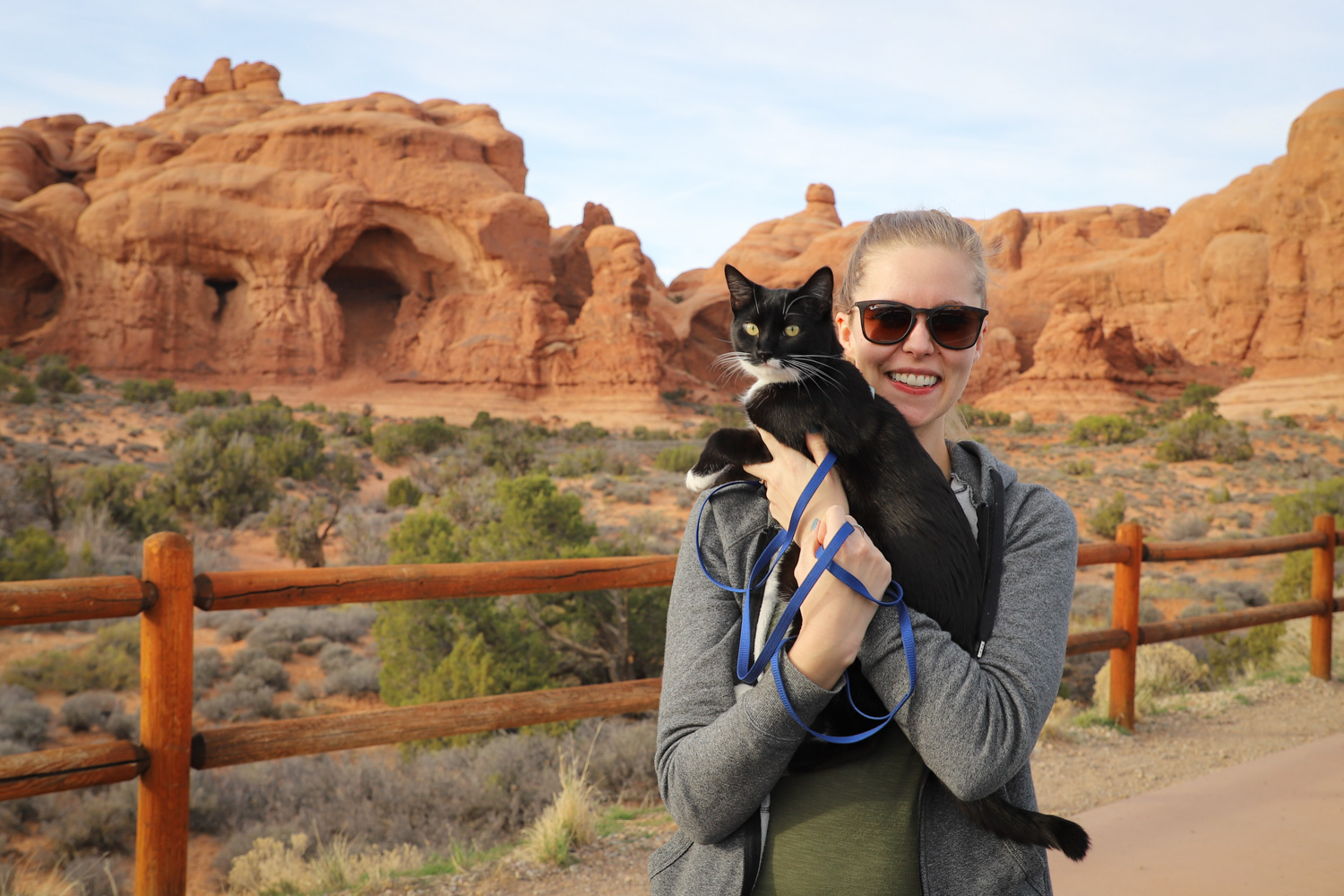
Travels with Josie:
Tips for Traveling With an Adventure Cat
Because some cats can be trained to love travel, too.
By Hailey Hirst
Part of me feels self-conscious when I’m on a trail (or a sidewalk, or at a truck stop) with a cat on a leash. But the better part of me can’t get enough of adventuring with my travel cat. I love going out into the world and savoring it differently with a soft, curious animal. And for the most part, she likes it too.
Since adopting my foster kitten, Josie, a year-and-a-half ago, she has accompanied me on thousands of miles of road trips. She’s slept in cabins, RVs, and motel rooms. She’s seen red rock deserts, mountain lakes, and feet of snow.
Even when it’s logistically more difficult, the experience of traveling with a cat offers more than the toll it can take on us. The effort is worth it for a lot of other people, too, it turns out.
Cats don’t have the long bred history of being outdoor-adventure companions or working animals like dogs do, but they can be leash trained. They’re naturally curious and relatively low-maintenance pets. With the right temperament and training, cats have the capability of becoming wonderful travelers (and even campers—although we haven’t tent camped yet).
This is what I’ve learned from going places near and far with my adventure cat:
Know your animal
Not all cat personalities are apt for adventure or travel. There are reportedly three main types of cat personality, two of which better suit outdoor/traveling lifestyles.
We chose a well-socialized kitten who was friendly, but somewhat cautious. She’s a tuxedo cat—not a distinct breed—but a bi-color marking pattern that’s said to denote a certain nature: lively, energetic, easygoing, social, intelligent. Tuxies are often compared to dogs in terms of personality. (She also plays fetch).
Once we got our “puppy cat” home, we built trust and learned her signals, and worked on training to see if she was up for becoming a leash-trained travel cat.
Go slowly and have patience
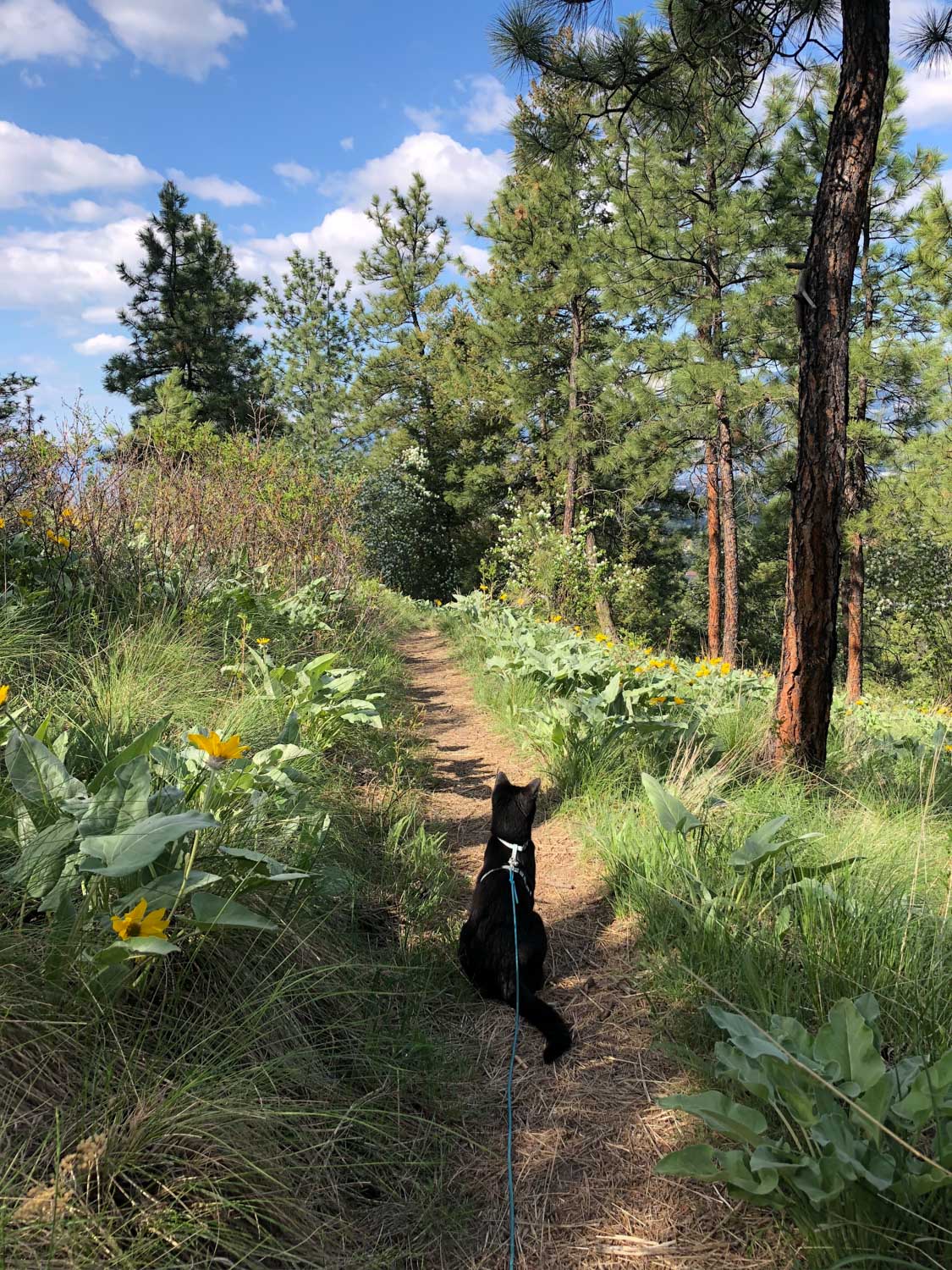 Both leash training and working up to a long trip (or even a normal-length walk or hike) take time.
Both leash training and working up to a long trip (or even a normal-length walk or hike) take time.
Start slow. Slap that harness on in your living room for the first time and watch your cat flop over and not move. Reward them with treats. Read more training tips and get them outside.
Remember—and this might seem obvious—cats are not dogs. They’re just not. Be patient and forgiving and love them for who they are.
Think your cat is too old to train? Maybe not! We started leash training immediately with Josie at eight-weeks-old. But her mom (who was adopted by another wonderful human) also took well to leash training as an adult. It’s part innate personality, and part patient training.
Enjoy the world through their eyes, at their pace
This takes patience, too. You won’t go as far or as fast with a cat in tow. But that can be a good thing if you embrace it.
Try to notice what they get held up investigating, and your walk might be richer for it. Stuck sniffing a branch? Ask yourself: what could have recently walked by here and rubbed their own animal scent on it? Chattering at something? Think about or look up: what type of bird might that be?
If they are moving all together too slowly (or not at all) they might need carried for a while, either in arms or in/on a backpack. Don’t be ridiculous. You don’t have ALL day. Or maybe you do?
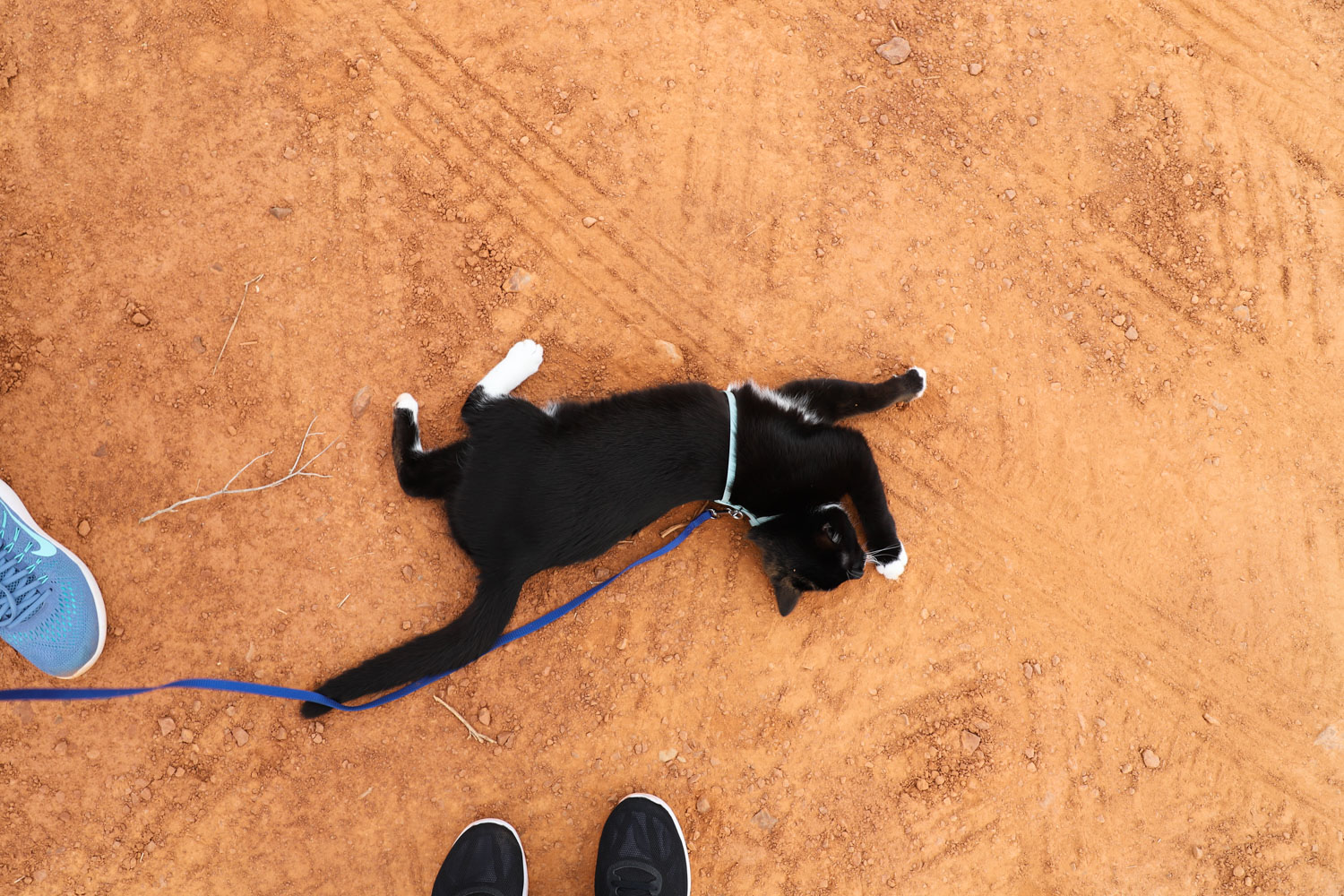
My travel cat has helped me slow down and be present. She lives in the here and now, enthralled by the scents, textures, plants, critters, and movement of places. With her, I notice more sounds and more birds. It’s a rich and dense way to be out in the world—wordless, aware, feeling.
Create a safe space
Cats are more territorial than nomadic by nature. If stressed or scared, it’s great to have somewhere they can retreat to that they know is safe. Maybe that’s a cat carrier or a vehicle, or a backpack. Maybe it’s just your arms (although some cover helps) so they’re up higher than a perceived threat. Having the option of retreat is a stress reliever—especially if you encounter other animals/noise/etc.
Chill out (your mood = their mood)
Cats are sensitive creatures. If they are getting extra stressed while outside or in a vehicle, take a moment to check in with your own mood. They might be mirroring your anxiety level.
This conveniently also works in a positive way. You can calm them with a serene disposition. Breathe in. Soothe your cat with a gentle voice, soft pets, and whatever else you know they like.
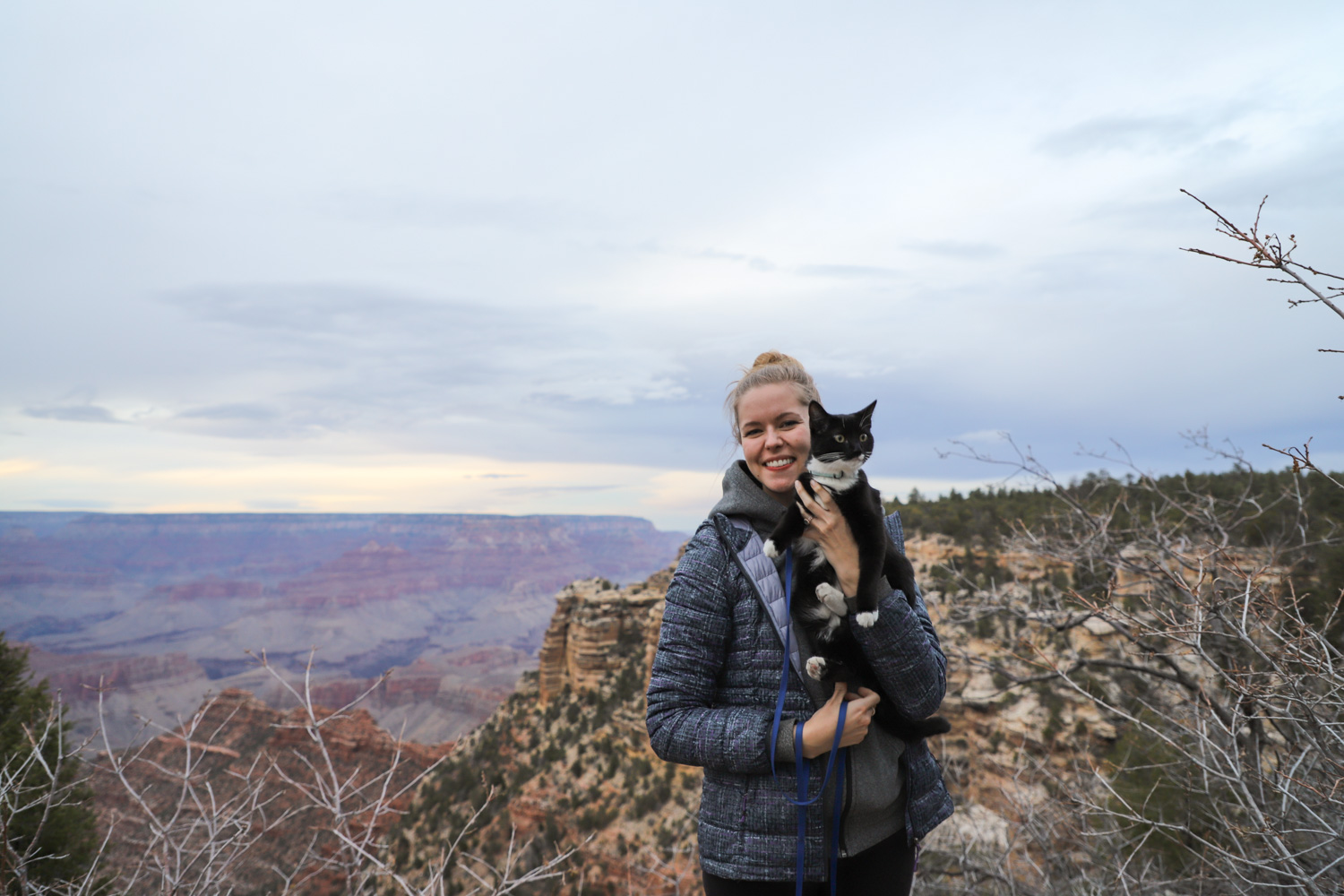
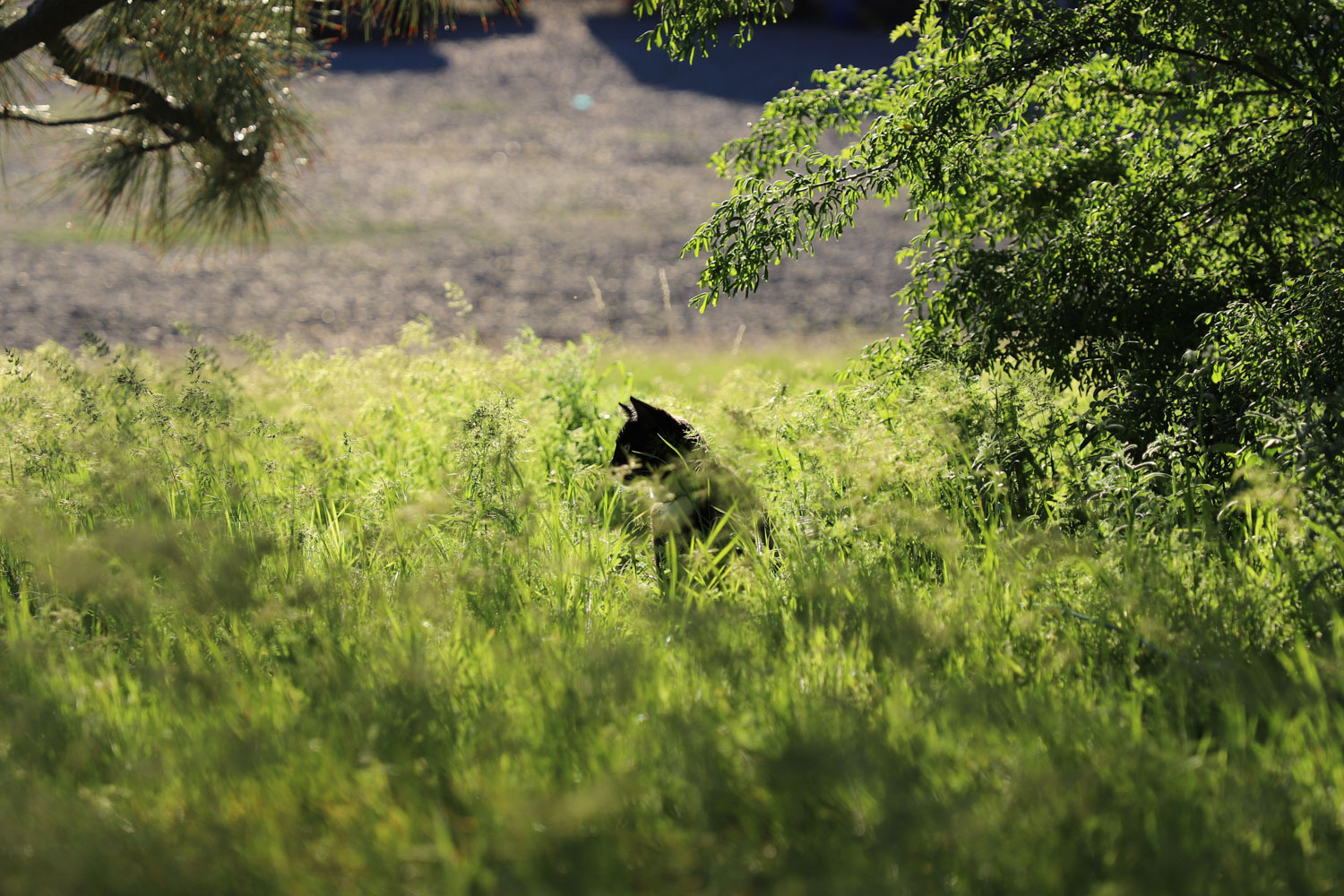
Be respectful
Whether you’re walking in your neighbourhood or taking your cat to a park, follow posted rules about pets. Keep your cat on leash (even if dogs are off-leash—maybe especially if dogs are allowed off-leash where you are).
And no matter where you are, be courteous with your pet. Not everyone loves them like you do. Stay only in pet-friendly accommodation. While we’ve never had to deal with accidents, they can happen. Clean up after them and Leave No Trace.
Wondering about the travel litter box situation? We bring one from home. She knows the routine. She never goes outside of it (except once in very soft dirt in an Airbnb’s backyard). Travel boxes exist in addition to eco-options, and some cats can be trained to use a toilet. You do you.
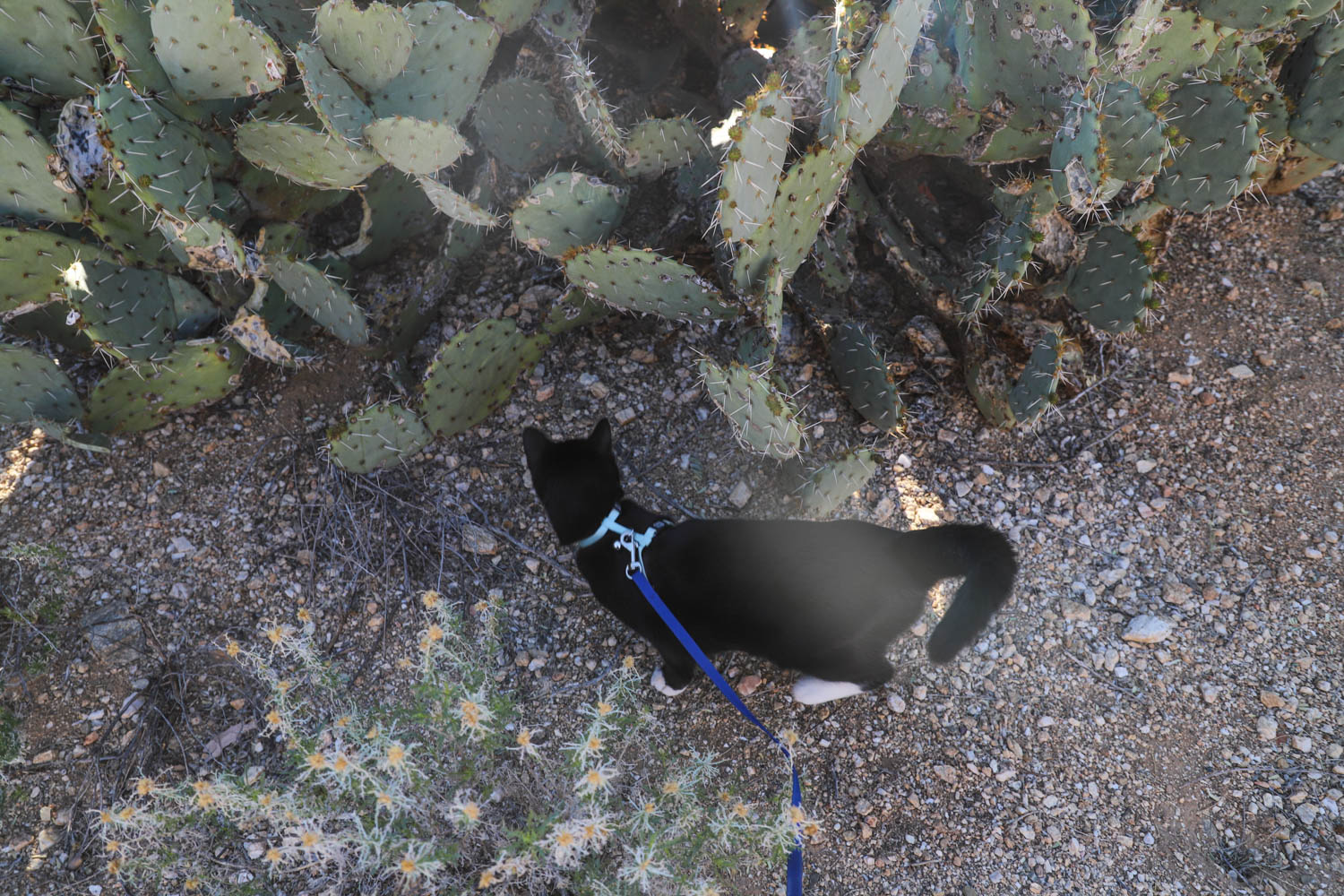
Leave them home sometimes
Or at your mom’s house, or at your pet-friendly Airbnb after they’ve settled in for a day or two. It’s okay. Just don’t leave them in a hot (or very cold) vehicle while you’re hiking or having lunch. That’s not safe or kind.
All in all, adventuring with a travel cat is not the same as going without them. Some modes of travel and certain places won’t suit your cat (or straight up won’t allow them)—and that’s okay. They’ll still be asleep when you get back. Just kidding. But maybe.
For more information and practical information about training, traveling, and cat stories, AdventureCats.org is a great resource. They are not affiliated with this post in any way, but I utilized their resources when I started leash training.







This is awesome. I am totally inspired for when my family one day adopts a cat.
I need help. My neighbor rescued 2 litters from feral mamas born in an unsafe place and bottle fed them. (I had the mamas spayed and helped home the kittens when they were weaned.) I fell in love with Kiki, a white calico, and a crazy girl. She’s vaccinated, spayed, chipped, and has been wearing a harness and leash, going to the park, and riding in the car since she was about 4 months old. Now she’s almost a year and seems to be turning into a homebody. I’d like to take her camping, but she’s not ready, and I don’t want to stress her. She comes when called inside, but refuses treats and calls outside. I work with her every day outside on the leash around the house. What else can I do?
Hi Carolyn! Do you think Kiki is refusing treats and calls outside because of stress or because she’s distracted/focusing on other stimulation? My cat Josie comes when called inside, but if she’s intently watching something outside she doesn’t always respond in the same way and she might in a quiet indoor environment.
As far as getting Kiki ready for camping, I’m definitely not an expert (we’ve only done RV and small cabin camping with Josie) but I’d recommend getting her acquainted with your camping setup in the safety of your home before venturing anywhere new, and making sure she always have a safe place she can retreat to if she does get stressed (like a carrier backpack, or maybe she learns that the tent is a safe place).
Have you figured out what environments/conditions seem to stress her out, and what she might tolerate better? Josie LOVES exploring new outside places and does great walking on trails, but if there are a lot of people or other animals she can get nervous—so we take her to quieter places to accommodate that need. We also have worked a lot socializing her with many other dogs and people, and frequently taking her various places (for walks in our neighborhood, to the park, to visit friends/family at their houses, and on all our road trips)—both to get her used to different situations, and to see how she does in each different environment. Sometimes she still gets scared and doesn’t want to leave the car, and that’s okay! We don’t force her. And if she seems stressed on a hike I’ll pick her up to affirm she’s safe and carry her for a while.
Ultimately, you know your cat best, so it’s all about figuring out what will work for her unique personality. Keep working with her like you are and try to find a balance between her needs and what you’d like her to do 🙂
Thanks for sharing your great insights, Hailey. I think she doesn’t respond to treats because she doesn’t feel completely safe. Cats are vulnerable when they are eating. That’s why they jump at cucumbers. They aren’t afraid of cucumbers, but will jump at anything that surprises them when their heads come up from a food dish. I take her on a lot of walks around the neighborhood and to the park across the street. However, now that Austin weather is in triple digits, I’m not going out until it cools off. I had an Outward Bound front pack for her. It was her safe space, but she outgrew it. Now she weighs nearly 10 pounds at about 10 months, a front pack is too much like being pregnant for me. I’m 72, and it was killing my back. I carry her a lot, as she lies down more than she walks. Isn’t a back pack inconvenient? You have to take it on and off every time kitty wants out or gets tired. Also most parks in Austin are dog friendly. She is fine with small dogs, but I understand feeling threatened by large ones. I’m thinking about a sling type carrier, so I can reach her while we are walking and still carry my own day pack. I wonder if anyone has tried this with a cat. I’m doing most of the things you are suggesting, so I’ll just keep on. She has become more secure outside in the last few months. I guess it just takes time.
Hi Hailey! Great article giving people the insight of what an outdoors cat is like. I trained my cat (RIP Rex :(!) to be outdoorsy around our neighborhoods and surrounding areas but he has not seen as much as your cat did! I just wanted to mention that I hope you take your cat to be checked up by the vet often especially since he’s outside more and this would be a great point to include in your article as well. My cat was actually sick and passed away out of the blue but we had no clue that he was in any type of pain because cats tend to not show it at all. It was such a devastating loss since Rex was with us for 8 years. It was our mistake and oblivion to not take the cat to the vet. Hope you guys are doing well though and keep on exploring together!
[…] Hirst of She-Explores likes to journey and her cat, Josie, is the perfect of street mates with the pair having […]